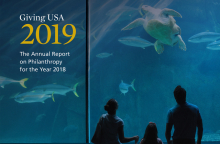On June 18, Americans for the Arts’ President and CEO Robert L. Lynch participated on a panel hosted by
The NonProfit Times that took an in-depth look at
Giving USA 2019: The Annual Report on Philanthropy for the Year 2018. The report was released that morning and is the longest-running and most comprehensive report of its kind in America.
Lynch commented after the webinar, “These Giving USA findings send a mixed message to America’s non-profit organizations. The public showed a hesitation in giving more support in 2018 than in 2017. Eight of 10 charitable sub-sectors showed a decline or a flat line in giving categories such as education, human services, health, arts, and religion—and the decline is even sharper when factoring in inflation. This decline in giving happened in a strong economy, which is not the usual pattern—usually when the economy is good, giving is up. The report provides early evidence that concerns surrounding the Tax Cuts and Jobs Act of 2017, and its change in donor behavior, may be well founded. In 2018, giving by individuals decreased for the first time in five years (down 3.4 percent) and dropped as a percentage of total giving to 68 percent (down from 70 percent in 2018).
“Regarding the arts specifically, the study shows a virtually flat 0.3 percent increase from 2017 to 2018, which is a decline of 2.1 percent when adjusted for inflation. Private sector giving accounts for about 30 percent of income to non-profit arts organizations, so as the culture industry continues to grow and expenses rise, a decline in giving or even flat giving from such a major resource area is not good news. Also, the arts have been successful in partnering more aggressively with other areas of society—through alliances with education, human services (in areas such as homelessness and youth services), health, and public society benefit areas such as community improvement. Unfortunately, each of these areas also showed a decline, so these partnership opportunities will not benefit from any increased availability of private sector dollars.
“In looking at the sources of dollars in the study which included individuals, bequests, foundations, and corporations, it is particularly concerning to the arts that individual giving and bequests showed a decline—both are very significant sources for the arts. A bright spot was total corporate giving, up 5.4 percent and 2.9 percent adjusted for inflation. For the arts, corporate and business giving is about 5 percent of the total average income. Our Americans for the Arts
Business Committee for the Arts has spent a great deal of time working to build relationships in and provide information to the corporate and business communities. We hope that private sector advocacy work has resonated and helped this trend.”
Highlights of Giving USA 2019 include:
-
In 2018, private sector giving to the arts, culture, and humanities—by individuals, foundations, and corporations—was $19.49 billion, up a fractional 0.3 percent from a revised $19.43 billion in 2017. When adjusted for inflation, however, this represents a 2.1 percent decrease.
-
The percentage of all charitable giving to the arts in 2018 held relatively steady at 4.6 percent. Maintaining a strong and steady share of overall philanthropy demonstrates relevance of the arts sector. Even small changes in the share of total philanthropy has significant financial implications.
-
Private contributions to all charities were up 0.7 percent (-1.7 percent when adjusted for inflation), reaching $424.74 billion in 2018.
-
Giving by foundations grew 7.3 percent to its highest dollar amount ever ($75.86 billion) and its largest ever share of all giving (18 percent).
-
Giving by individuals, however, decreased for the first time in five years (-3.4 percent) to $292.09 billion. Giving by individuals dropped as a percentage of total giving to 68 percent (down from 70 percent in 2017).
-
Giving by corporations increased 5.4 percent to $20.05 billion. Corporate giving is highly responsive to changes in corporate pre-tax dollars and GDP. It includes cash and in-kind contributions made through corporate giving programs, as well as grants and gifts made by corporate foundations.
The panel was hosted by Paul Clolery and Mark Hrywna of The NonProfit Times. Lynch was joined on the panel by Jacob Harold, Executive Vice President at Candid, and Una Osili, Ph.D., Associate Dean for Research and International Programs at the Lilly Family School of Philanthropy.
Giving USA is published by Giving USA Foundation, a public service initiative of The Giving Institute, researched and written by the Indiana University Lilly Family School of Philanthropy at Indiana University/Purdue University in Indianapolis, Indiana.






